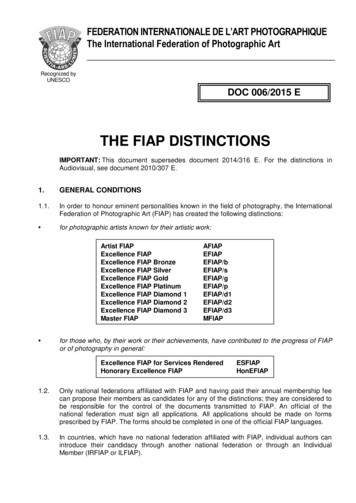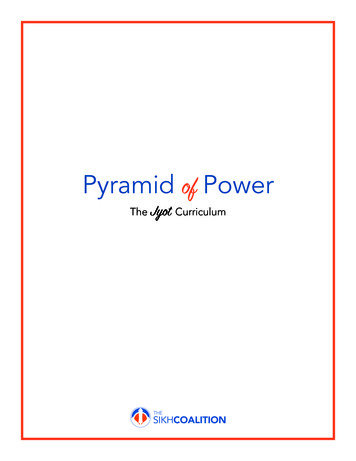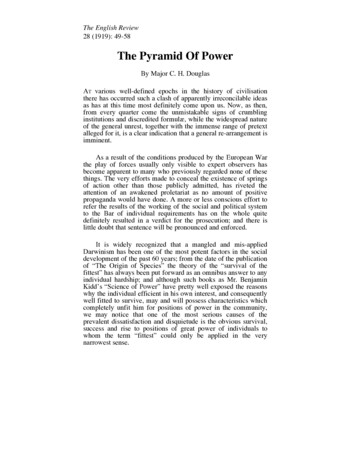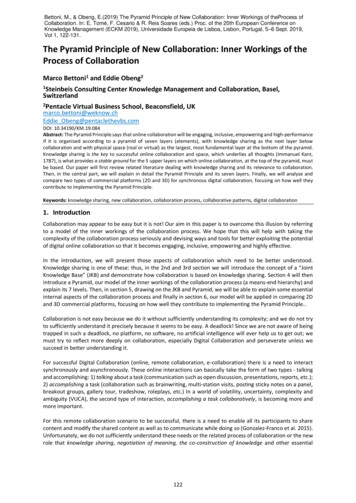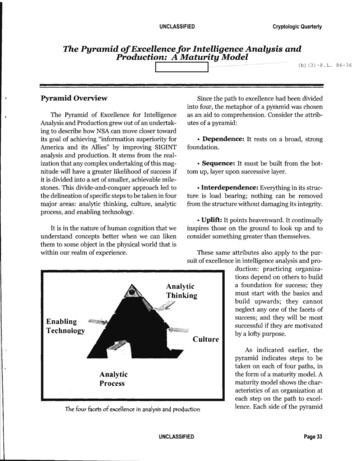
Transcription
UNCLASSIFIEDCryptologic QuarterlyThe Pyramid of Excellence for Intelligence Analysis andProduction: A Maturity ModelIIPyramid OverviewThe Pyramid of Excellence for IntelligenceAnalysis and Production grew out of an undertaking to describe how NSA can move closer towardits goal of achieving "information superiority forAmerica and its Allies" by improving SIGINTanalysis and production. It stems from the realization that any complex undertaking of this magnitude wiJI have a greater likelihood of success ifit is divided into a set of smaller, achievable milestones. This divide-and-conquer approach led tothe delineation of specific steps to be taken in fourmajor areas: analytic thinking, culture, analyticprocess, and enabling technology.It is in the nature of human cognition that weunderstand concepts better when we can likenthem to some object in the physical world that iswithin our realm of experience.(b) (3)-P.L.Since the path to excellence had been dividedinto four, the metaphor of a p:Yramid was chosenas an aid to comprehension. Consider the attributes of a pyramid: Dependence: It rests on a broad, strongfoundation. Sequence: It must be built from the bottom up, layer upon successive layer. Interdependence: Everything in its structure is load bearing; nothing can be removedfrom the structure without damaging its integrity. Uplift: It points heavenward. It continuallyinspires those on the ground to look up and toconsider something greater than themselves.These same attributes also apply to the pursuit of excellence in intelligence analysis and production: practicing organizations depend on others to builda foundation for success; theyAnalyticmust start with the basics andThinkingbuild upwards; they cannot., .;7,-,. neglect any one of the facets ofsuccess; and they will be mostsuccessful if they are motivatedby a lofty e four fucets of excellence in analysis an pro uctlonUNCLASSIFIEDAs indicated earlier, thepyramid indicates steps to betaken on each of four paths, inthe form of a maturity model. Amaturity model shows the characteristics of an organization ateach step on the path to excellence. Each side of the pyramidPage 3386-36
UNCLASSIFIEDCryptologic Quarterlyactually describes a separate maturity model asfollows.The following sections describe each of thefacets of the pyramid in detail. On the analytic thinking side, increasinglevels of complexity of analytical thought areexercised as one moves from the base of the pyramid to the apex.The Pyramid Base On the analytic process side, an organization gradually becomes more self-aware abouthow it does its business and more deliberateabout its process focus. The culture side has to do with why peoplebehave as they do in the workplace. As an organization's culture matures, change becomes lessand less painful as it becomes a way of life. The enabling technology side describes acontinuum of the degree to which machines areactual participants in analysis, in which they gofrom being useful but dumb work adjuncts tobeing intelligent and integrated with the analyst.A pyramid is not constructed directly on sand.For the sake of stability, any large masonry structure must be supported by a strong foundation.The Pyramid of Excellence for IntelligenceAnalysis and Production presumes a foundationconsisting of the following elements: a robust and flexible information technologyinfrastructure a critical mass of people with the skills andattributes needed for analytic excellence a productive physical work environment partners, both within and outside NSA, whounderstand their roles and responsibilitiesThese are the prerequisites for success in any intelligence analysis and production endeavor.Analytic ThinkingThe purpose of intelligence analysis and production is, in the words of intelligence production textbook"toreveal to a specific decisionmaker the underlying significance of selected targetinformation." Excellence inanalysis means employingthinking skills that add valueto information, to the extentdesired by intelligence consumers. Thus the analyticIAnalytic ProcessThe pyt lmid of excellence for intelligence 1n 1lysis & productionPage 34thinlng sideusesIol.hierarchythe······/ PyramidofUNCLASSIFIED(b)(3)-P.L. 86-36
UNCLASSIFIEDthinking skills to describe the value-adding tasksthat analysts must be able to do, listed in ascending order of complexity:Cryptologic Quarterly clear organizational direction (vision, strategy, goals and objectives) employee involvement (team orientationand empowerment) describing facts and events explaining the context for those facts andevents, including observations about patterns orchanges in observed behavior interpreting the significance of theobserved phenomenon, making judgments aboutwhat has happened estimating, or making judgments aboutwhat might happen in the future as a result ofobservations and interpretationsWorkplace CultureCulture is "a particular way of life among apeople or community," 2 according to organizational theorist Mal)' Jo Hatch of the CranfieldSchool of Management in England. Hatchexplains that every organization has a set ofbeliefs and assumptions that are widely sharedamong its members. Those beliefs and assumptions shape the organization's values and behaviors, and those values and behaviors areexpressed in observable cultural "artifacts" suchas rituals and ceremonies, rewards and punishments, stories and myths.The goal on the culture side of the Pyramid isto become a continuously adaptive and innovative organization in which diverse communities ofinterest can coexist and still work together towardthe common goal of "information superiority."To achieve the desired state, we must re-examineour values and assumptions, and consciously andcreatively use artifacts to express a new organizational identity. According to research on organizational culture, 3 the set of values for a high-performance culture includes the following: adaptability (customer focus and organizational learning)The culture side of the Pyramid describes aprocess for implementing culture change andinstilling the high-performance values asdescribed above. The basis of a healthy organizational cultureis the existence of a unified corporate vision anddirection. Everyone in the organization musthave a clear and common understanding of thatvision (i.e., all the visions and strategies are inalignment). The organization can really start its transformation by adopting changes designed to alterbehaviors. In the transformation stage, actionsare centered on changing incentives and disincentives, instituting meaningful metrics, revamping policies, removing barriers, and buildingtrust. The organization that has matured to theevolution stage is actively monitoring its progresstoward its objectives, allowing learning to occur(viewing mistakes as an opportunity for improvement), and managing risks rather than avoidingthem. The new values are starting to take hold. Finally, at the pinnacle, the organization canbe said to be exhibiting the qualities of the trulyinnovative and adaptive culture: systematic problem solving, active experimentation, learningfrom experience, enthusiastically borrowingideas from others, and transferring knowledgereadily and efficiently.UNCLASSIFIEDPage 35
Cryptologic QuarterlyUNCLASSIFIEDAnalytic Process"An organization is only as effective as itsprocesses," say performance improvementexperts Geary Rummler and Alan Brache. 4 Theyobserve that organizations have processes for getting work done whether or not they are madeexplicit. So we have two fundamental choices:1) ignore our processes and hope they do whatwe want them to do or 2) understand them andmanage them.On the analytic process facet of the Pyramid,organizational excellence means choosing optiontwo. Drawing upon the Rummler & Brachemethodology, reaching the apex on the processside involves the following: An organization in the reactive stage is largely event-driven. It may have many good individ-ual and group processes, but they exist in isolation from one another. At the rationalized stage, an organization'sexisting processes are documented so that theycan be studied, repeated, and/or modified. Bestpractices and inefficiencies are identified. The adaptive stage is characterized byprocess management. This means that the organization performs continuous process monitoringand improvement. It routinely reviews existingprocesses to determine continued applicability tonew conditions. Finally, at the proactive stage, the organization is managed as a complete system. The interdependency of different subprocesses of thewhole system is recognized; when changes areconsidered to one process, the potential effects onother processes are considered as well.high-performance organizational culture, andstreamline analytic processes. This is often theaspect of attaining excellence in intelligenceanalysis and production that is given the mostattention, although it is by no means the mostimportant. Best-selling author Jim Collins (Builtto Last and Good to Great) has found throughextensive research that, of the companies knownto have gone from being merely good to beinggreat, none of them accomplished that feat byfocusing on technology first. Hence the enablingtechnology facet brings up the rear in thisroundup of factors to consider.The technology needs for analysis and production are described on the Pyramid as a continuum of increasing sophistication. This mirrorsthe tendency toward increasing computer sophistication or even "sentience" noted by prominentthinkers such as Ray Kurzweil (The Age ofSpiritual Machines) and James Martin (AlienIntelligence), which will allow humans to accomplish more and more in conjunction withmachines.The continuum of sophistication can be divided into the following levels: At the lowest level, technology is there toassist the human in performing basic tasks rapidly, such as viewing, storing, and routing data. At the next level, the technology begins tointeract with the human. Data can be manipulated and displayed in new ways, yielding analyticresults not previously possible. The machinesnotify humans about patterns and anomalies indata. Technology can collaborate with humans bytracking their needs and preferences, then alerting them to new opportunities.Enabling TechnologyWe must have appropriate technologies toaugment human analytic thinking, support aPage 36 When it is fully integrated into the business,technology anticipates humans' wants and needs,proposes analytic conclusions or courses ofUNCLASSIFIED
UNCLASSIFIEDaction, and makes rational decisions on theirbehalf, if desired.Using the PyramidThe maturity models represented by thePyramid of Excellence show the organization aplan for building from the ground up. ThePyramid has two primary uses:Cryptologic QuarterlyAcknowledgmentsThe Pyramid concepts were first elaboratedby a number of people working together. Manythanks go to Carl Solomon, Brian Mallare, DonnaBer, Dale Roberts, Wendy Steward, John Walker,Dottie Jackson, Jim Laubert, Colleen Palmer, JayPeltz, Dan Aldridge, Arnold Landvoigt, NeilMuhlberger, Jerry Ingley, S. Johnson, LisaKrizan, Joe Meyer, and David Moore.1. It can guide the corporation in settingstrategically oriented priorities for investingmoney, time, and energy. It constantly remindsdecision makers that we need to ensure that thebasic business needs are taken care of before wetrain our efforts on reaching the apex.2. Tied to a set of measures, it can provide abenchmark for estimating and tracking organizational performance. Product lines can use thePyramid to set goals (e.g., "we intend to achieve atleast level two performance in all facets across theentire product line by the middle of next year").Individual business unit progress toward thosegoals can then be recognized and rewarded.Notes2. Mary Jo Hatch, Organization Theory, OxfordUniversity Press, 1997, 204.3. W. Mathew Juechter, Caroline Fisher, andRandall J. Alford, "Five Conditions for HighPerformance Cultures," Training &Development,Mayl998.4. Geary A. Rummler &/Alan P. Brache,Improving Performance, Jossey-Bass Publishers,1995.(b) (3)-P.L.(U)I(b)-(6)86-36Ihasperformance improvement advisor in/ AnalysisProduction (S2) since April 2001. She is currently working on ways ·to help business units in S2 achieveorganizational excellence. Since 1988 she has held avariety of positions at NSA in both IGINT roduction and technolo y mana ement.recent awards include a SuperiorL.e""'r"""' ."".s Award from the former Di rectora tof Technology.UNCLASSIFIEDPage 37
Best-selling author Jim Collins (Built to Last and Good to Great) has found through extensive research that, of the companies known to have gone from being merely good to being great, none of them accomplished that feat by focusing on technology first. Hence the enabling technology facet
